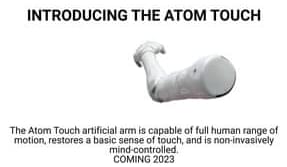The concept of Transhumanism has been around for a long time, but it actually looks like it’s starting to happen. In today’s video, we will look at how humans are already merging with machines and what will come next. IPhone wireless charging cases — https://amzn.to/3bz0oRg.
IPhone Backup — https://amzn.to/3w8Usbj.
Wireless Earbuds — https://amzn.to/2ZTjwau.
IPhone Bargains — https://amzn.to/3jXvCGb**** Gears and Equipment we use****
1. Fully Automatic Espresso Machine — https://amzn.to/3bdHcbr.
2. Perfect Desk Chair — https://amzn.to/2ZlMNd2
3. Wireless Mechanical Keyboard — https://amzn.to/3pA71Lw.
4. Wireless DTS Headphone — https://amzn.to/3juz2Qv.
5. Vocal Microphone — https://amzn.to/2XEDsN4
6. UltraWide Monitor — https://amzn.to/3jyteWg**** Free Handy Tools YOU must try ****Tubebuddy – https://bit.ly/3y0SOc6
In-depth channel/video analysis, SEO statistics, Channel optimizationHere at Future Now we aim to bring you the most informative, fascinating and engaging Technology videos on YouTube.🔔 Subscribe To Our Channel: https://bit.ly/3nRoVH8
Copyright Disclaimer:
Under section 107 of the Copyright Act 1976, allowance is made for “fair use” for purposes such as criticism, comment, news reporting, teaching, scholarship, education and research. Fair use is a use permitted by copyright statute that might otherwise be infringing. Non-profit, educational or personal use tips the balance in favor of fair use. *DISCLOSURE*
We are affiliated, but not sponsored by any product featured in this video.
Some links in the description are affiliate links to products, which means if you click on them and buy the product, we will receive a small commission.
Not being sponsored allows us to keep our own opinions and provide product reviews without bias. From the millions of products, we appreciate your support.#Exoskeleton #Cyborg #Transhumanism
Category: cyborgs – Page 50


Artificial intelligence can offset human frailties, leading to better decisions
Modern life can be full of baffling encounters with artificial intelligence—think misunderstandings with customer service chatbots or algorithmically misplaced hair metal in your Spotify playlist. These AI systems can’t effectively work with people because they have no idea that humans can behave in seemingly irrational ways, says Mustafa Mert Çelikok. He’s a Ph.D. student studying human-AI interaction, with the idea of taking the strengths and weaknesses of both sides and blending them into a superior decision-maker.
In the AI world, one example of such a hybrid is a “centaur.” It’s not a mythological horse–human, but a human-AI team. Centaurs appeared in chess in the late 1990s, when artificial intelligence systems became advanced enough to beat human champions. In place of a “human versus machine” matchup, centaur or cyborg chess involves one or more computer chess programs and human players on each side.
“This is the Formula 1 of chess,” says Çelikok. “Grandmasters have been defeated. Super AIs have been defeated. And grandmasters playing with powerful AIs have also lost.” As it turns out, novice players paired with AIs are the most successful. “Novices don’t have strong opinions” and can form effective decision-making partnerships with their AI teammates, while “grandmasters think they know better than AIs and override them when they disagree—that’s their downfall,” observes Çelikok.
Scientists are developing a robot with electronic HAIRS
But the bizarre invention could soon become a reality, as scientists have taken a major step forward in the development of electronic skin with integrated artificial hairs.
Hairs allow for ‘natural touch’ and let us detect different sensations such as rough and smooth, as well as the direction the touch is coming from.
Researchers from Chemnitz University of Technology say the ‘e-skin’ could have a range of uses in the future, including skin replacement for humans and artificial skin for humanoid robots.

Engineer born with one hand makes a prosthetic one out of plastic bottles for $800
The Force was strong in him. One of Enzo Romero’s favorite activities is playing the guitar, which he effortlessly does with his bright blue hand. Initially, it used to hurt, as he used his handless right arm to press down on chords. But now, with fingers on the end, he can play music painlessly.
Star Wars: Episode V The Empire Strikes Back, marketed as simply The Empire Strikes Back, is a 1980 film directed by Irvin Kershner and written by Leigh Brackett and Lawrence Kasdan from a story by George Lucas. It is the second part of the Star Wars original trilogy.
The film concerns the continuing struggles of the Rebel Alliance against the Galactic Empire. During the film, Han Solo, Chewbacca, and Princess Leia Organa are being pursued across space by Darth Vader and his elite forces. Meanwhile, Luke Skywalker begins his major Jedi training with Yoda, after an instruction from Obi-Wan Kenobi’s spirit. In an emotional and near-fatal confrontation with Vader, Luke is presented with a horrific revelation and must face his destiny.
Though controversial upon release, the film has proved to be the most popular film in the series among fans and critics and is now widely regarded as one of the best sequel films of all time, as well as one of the greatest films of all time. It was re-released with changes in 1997 and on DVD in 2004. The film was re-released on Blu-ray format in September of 2011. A radio adaptation was broadcast on National Public Radio in the U.S.A. in 1983. The film was selected in 2010 to be preserved by the Library of Congress as part of its National Film Registry.


New breakthrough 3D printed fingertip feels and acts like human skin
The researchers were inspired by actual skin. Researchers have been working on robot dexterity for several years now trying to give the machines human-like sensitivity. This has been no easy task as even the most advanced machines struggle with this concept.
Now the team is working on making the artificial fingertip as sensitive to fine detail as the real thing. Currently, the 3D-printed skin is thicker than real skin which may be hindering this process. As such, Lepora’s team is now working on 3D-printing structures on the microscopic scale of human skin.
“Our aim is to make artificial skin as good – or even better — than real skin,” concluded Professor Lepora. The end result could have many applications in soft robotics including in the Metaverse.

You’re invited to join our subreddit community —
R/IntelligenceSupernova — dedicated to techno-optimists, singularitarians, transhumanist thinkers, cosmists, futurists, AI researchers, cyberneticists, crypto enthusiasts, VR creators, artists, philosophers of mind. Accelerating now towards the Cybernetic Singularity with unprecedented advances in AI & Cybernetics, VR, Biotechnology, Nanotechnology, Bionics, Genetic Engineering, Optogenetics, Neuroengineering, Robotics, and other IT fields.
Join now: https://www.reddit.com/r/IntelligenceSupernova.
#Subreddit #IntelligenceSupernova